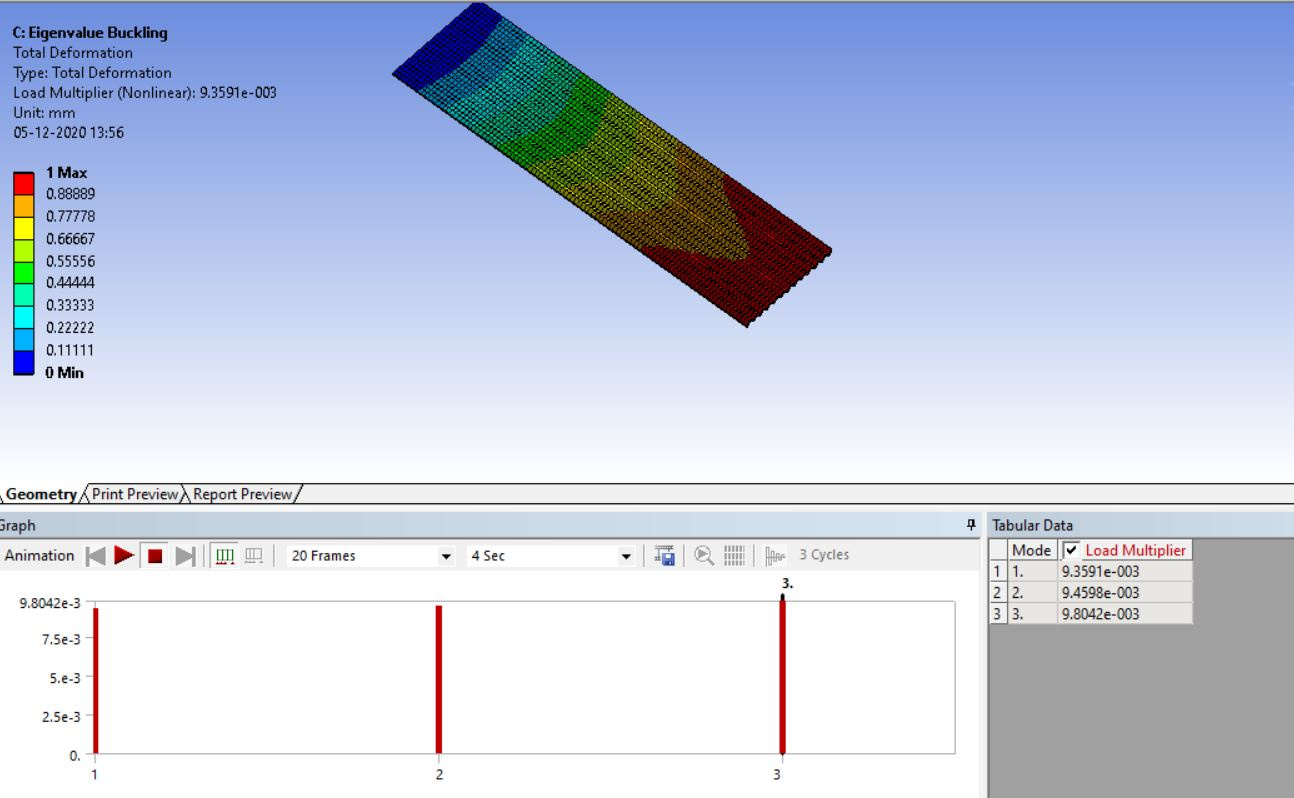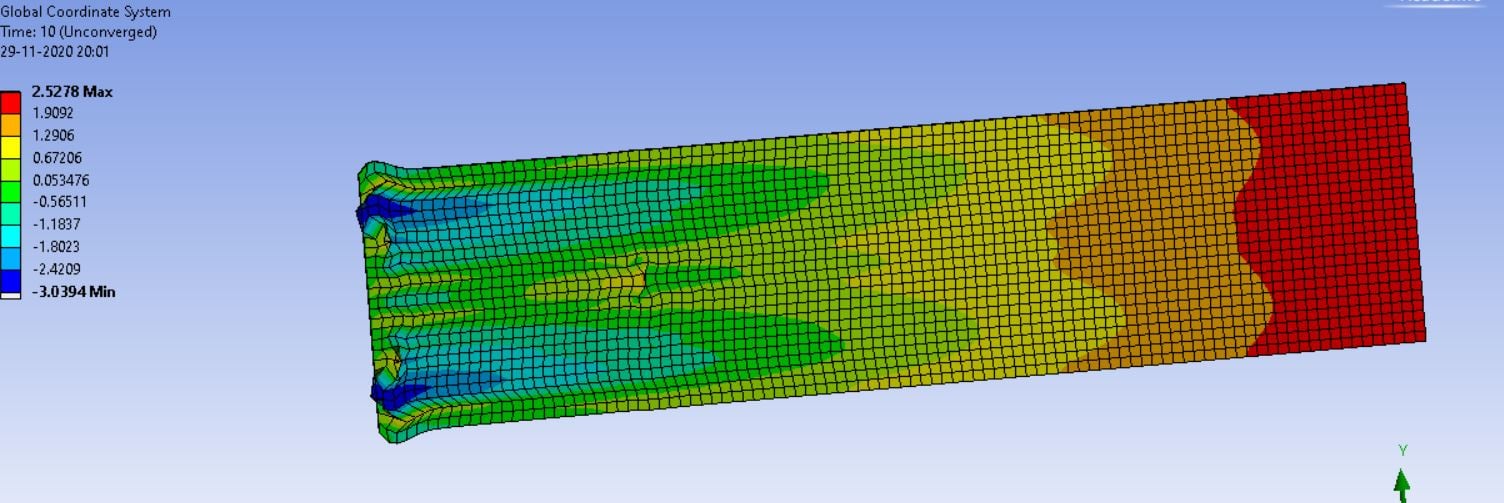-
-
November 29, 2020 at 7:32 pm
name11
SubscriberNovember 30, 2020 at 4:21 ampeteroznewman
SubscribernCan you share the Workbench Project Archive .wbpz file? If so, put it in a .zip file and attach it to your reply.nNovember 30, 2020 at 4:55 pmname11
SubscriberI have attached the required file. Thanks.nnDecember 1, 2020 at 3:13 ampeteroznewman
SubscribernThere is a potential mistake when using an Orthotropic material with shell elements that the element coordinate system doesn't align with the Global coordinate system. See this discussion. /forum/discussion/515/shell-element-with-orthotropic-materials-gives-very-different-results-from-experimental-data#comment-e7d844c9-0cc3-468a-b493-a82b00ea5abbnIn your case it happens to have worked out that the element coordinate system aligned with the global coordinate system, but you can't count on that. nI didn't like the values you had for Shear Modulus.n I came up with values that were consistent with the isotropic relationship.n
I came up with values that were consistent with the isotropic relationship.n The sheet is 200 mm long x 50 mm wide x 1 mm thick. I see that the solution fails to converge after stretching it about 2.4 mm along the length. The reason is that the sheet will buckle, which means the structure will suddenly change its deformation from just being stretched to going sideways in some manner.nANSYS has an Eigenvalue Buckling Analysis. If you setup the Static Analysis to pull just 1 mm, where it has no problem converging, then run the Eigenvalue Buckling analysis after that, it will calculate that the critical load factor is 2.8 or 2.8 mm since the applied load was 1 mm.nIt is possible, but very challenging, to simulate the post-buckling behavior of a structure.nWhat is the goal of this analysis? Is 2 mm of stretch (1% strain) sufficient? Why do you need to stretch it to 5 mm? Is the post-buckled state important to see?nAttached is an ANSYS 19.0nn
December 5, 2020 at 1:27 pm
The sheet is 200 mm long x 50 mm wide x 1 mm thick. I see that the solution fails to converge after stretching it about 2.4 mm along the length. The reason is that the sheet will buckle, which means the structure will suddenly change its deformation from just being stretched to going sideways in some manner.nANSYS has an Eigenvalue Buckling Analysis. If you setup the Static Analysis to pull just 1 mm, where it has no problem converging, then run the Eigenvalue Buckling analysis after that, it will calculate that the critical load factor is 2.8 or 2.8 mm since the applied load was 1 mm.nIt is possible, but very challenging, to simulate the post-buckling behavior of a structure.nWhat is the goal of this analysis? Is 2 mm of stretch (1% strain) sufficient? Why do you need to stretch it to 5 mm? Is the post-buckled state important to see?nAttached is an ANSYS 19.0nn
December 5, 2020 at 1:27 pmname11
SubscriberThanks for the Help. Post buckled exact state is not needed and i think 1% strain is enough to represent plastic behaviour.nI did the eigen value Buckling analysis, one with previous properties and the other what you suggested, but in neither of the cases i could get the critical load factor as 2.8.nn
 n
December 5, 2020 at 3:00 pmDecember 7, 2020 at 9:26 am
n
December 5, 2020 at 3:00 pmDecember 7, 2020 at 9:26 amname11
SubscriberThanks for your Help Sir. Is it possible to attain such result in Ansys by keeping large deflections On?nDecember 8, 2020 at 1:55 ampeteroznewman
SubscriberYou can perform the Static Structural analysis with Large Deflection On. The eigenvalue buckling is a linear analysis. The best way to use this is to increase or decrease the load in static structural until the Load Multiplier comes close to 1.0nDecember 8, 2020 at 6:59 amname11
SubscriberI mean, is at least 4% strain achievable? As you've mentioned before it's difficult as the sheet starts to buckle after 2.8 mm and hence convergence problem.nDecember 9, 2020 at 12:47 ampeteroznewman
SubscribernStatic Structural can simulate post-buckling behavior in many cases. I don't know if 4% is achievable in your case.nDecember 10, 2020 at 7:48 pmname11
SubscriberHello Sir, I am finding this warning every time i am trying to solve ''One or more remote boundary conditions is scoped to a large number of elements which can adversly affect solver performance. Consider using the pinball setting to reduce the number of elements included in the solver''.nI tried using pinball for contact but not getting it. I am attaching my geometry and boundary conditions.nnDecember 12, 2020 at 11:15 ampeteroznewman
SubscribernDon't worry about this warning. You want all the elements on that face to be included.nViewing 11 reply threads- The topic ‘Convergence Problem with orthotropic material’ is closed to new replies.
Innovation SpaceTrending discussions- LPBF Simulation of dissimilar materials in ANSYS mechanical (Thermal Transient)
- Convergence error in modal analysis
- APDL, memory, solid
- Meaning of the error
- How to model a bimodular material in Mechanical
- Simulate a fan on the end of shaft
- Real Life Example of a non-symmetric eigenvalue problem
- Nonlinear load cases combinations
- How can the results of Pressures and Motions for all elements be obtained?
- Contact stiffness too big
Top Contributors-
4167
-
1487
-
1363
-
1194
-
1021
Top Rated Tags© 2025 Copyright ANSYS, Inc. All rights reserved.
Ansys does not support the usage of unauthorized Ansys software. Please visit www.ansys.com to obtain an official distribution.
-
The Ansys Learning Forum is a public forum. You are prohibited from providing (i) information that is confidential to You, your employer, or any third party, (ii) Personal Data or individually identifiable health information, (iii) any information that is U.S. Government Classified, Controlled Unclassified Information, International Traffic in Arms Regulators (ITAR) or Export Administration Regulators (EAR) controlled or otherwise have been determined by the United States Government or by a foreign government to require protection against unauthorized disclosure for reasons of national security, or (iv) topics or information restricted by the People's Republic of China data protection and privacy laws.














